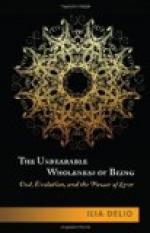At the time when spiritual love, accompanied by eccentricities and Latin treatises, gradually, and amidst heavy conflict, struggled into existence, the soul of woman was already glowing with the emotion which we, to-day, realise as love. I have three witnesses to prove this statement. The Lais of the French poetess Marie de France, based on Breton and Celtic motifs, are permeated by a sweet sentimentality, very nearly related to the sentiment of our popular ballads. They tell of simple feelings, of love and longing and the grief of love. One of her lais treats the touching story of Lanval and Guinevere, and another an episode of Tristan and Isolde.
De Tristan et de la
reine,
De leur amour qui tant
fut fine,
Dont ils eurent mainte
doulour
Puis en moururent en
un jour.
The naive sentiment of these poems forms a delicious contrast to the contemporaneous mature and subtile art of Provence, and the entire erudite armoury of love.
A great baron declared that only the man who could carry his daughter in his arms to the summit of a certain mountain—an impossible feat—should win her hand in marriage. No man possessed strength to carry her farther than half way. But the knight whom she loved secretly went out into the world, and after years of searching, discovered a magic potion able to endow him who quaffed it with enormous strength. Full of joy he returned home and, his beloved in his arms, began the laborious ascent. Strong and jubilant, he laughed at the potion. But after a while, feeling his strength ebbing away, the maiden implored him: “Drink, I beseech thee, beloved!” “My heart is strong, to drink were waste of time.” And again she pleaded: “Drink now, beloved, thy strength is diminishing fast.” But he, eager to win her only by his own effort, staggered on and reached the summit, only to sink to the ground and expire. The maiden, throwing herself on his lifeless body, kissed his eyes and lips and died with him.
We recognise in this simple tale the new form of love, mutual devotion, and the thought of the consummation of this love, the Love-death, which was not definitely realised until six hundred years later. It originated in the Celtic soul, as the worship of woman originated in the Romanesque (the Teutonic soul shared in the development of both). It was a dream of the suppressed Celtic race, spending its whole soul in dreams and producing visions of such depth and beauty that even we of to-day cannot read them without being profoundly moved.
Next there are three love-letters written in Latin by a German woman of the twelfth century. In very touching words she tells her lover that the love of him can never be torn out of her heart. “I turn to you whom I hold for ever enclosed in my inmost heart.” She promises and claims faithfulness until death: “Among thousands my heart has chosen you, you alone can satisfy my longing, and you will never find my love wanting. I trust myself to you, all my hope is centred in you. I could say a great deal more,” she concludes, “but there is no need of it.” And then follow the charming German stanzas:




